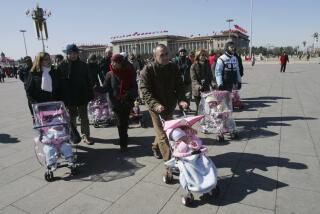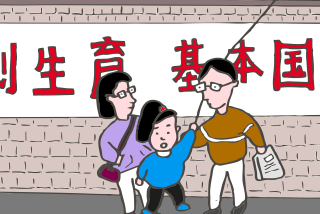China eases its one-child policy
- Share via
BEIJING — China announced Friday that it would ease its deeply unpopular one-child policy, a high-profile move by new leaders to limit a program that has prevented millions of births but helped create an aging population that could constrict economic growth.
The decision to allow couples to have a second baby if either is an only child is part of a reform package that includes abolishing the much-criticized “re-education through labor” program, which allows people to be sent to labor camps for up to four years without trial.
The Communist Party also promised to respect property rights and reduce confiscation of land, a major grievance for farmers, who have largely missed out on the real estate boom that has made many urban Chinese rich.
The reforms were enacted at a four-day plenum of the Communist Party’s Central Committee last week and announced on the evening news — China’s most widely watched television program — an indication of the importance the leadership attaches to them.
The measures are among the first major policy moves by the new leadership under Xi Jinping, who became head of the Communist Party late last year and president in March. All of the reforms had been under discussion for years, but they were stalled during Hu Jintao’s presidency, which many China watchers refer to as a decade of paralysis.
Xi has been eager to prove himself a more forceful and decisive president.
The change in the one-child policy is likely to have the most immediate effect on Chinese families. Demographers have estimated that such a change would allow about 10 million couples to have a second child. The current law allows only couples in which both are only children to have a second baby.
Since the one-child law was introduced in 1980, Communist Party officials have tweaked it repeatedly, allowing myriad exceptions — for minorities, for rural families without boys, for people with disabled children. But there have been few major amendments of this kind.
The party said it would adhere to the principle of limiting family size while promoting the “long-term balanced development of the population of China.”
China’s National Health and Family Planning Commission says the law has reined in the country’s population growth, preventing 400 million births. China’s population is 1.3 billion.
Demographers say the impact of the law on population growth has been exaggerated and that it instead has led to a gender imbalance, with more boys than girls born. Furthermore, they say, the low birthrate is beginning to impair China’s economic growth, creating a population with too many old people and too few workers.
According to the 2010 census, China’s fertility rate was 1.18 children per woman, far below the level needed for the population to replenish itself.
“In the 1980s, when the one-child policy was implemented, it was needed to stop the rapid population growth and increase per-capita income,” said Zhou Haiwang, an expert in population studies at the Shanghai Academy of Social Sciences.
“Now, 30 years later, it has achieved that goal. Now it is time to increase the fertility rate to benefit our society in the long term,” Zhou said.
The policy, a bedrock of the Communist Party’s social engineering, has been deeply unpopular. In the 1980s, female factory workers had to show family planning officials their stained sanitary napkins to record their menstruation.
“We called them the ‘period police.’ They wanted to make sure you weren’t pregnant,” said Lijia Zhang, a Beijing-based writer and social commentator. “At the time, we didn’t think it was intrusive. It was just the way things were in China.”
Although enforcement has eased, family planning officials are still frequently accused of forcing women to undergo abortions, often late in pregnancy, or to be sterilized against their will.
Meanwhile, rich families have been able to skirt the one-child law by going abroad to give birth or paying large fines. Reports this year said film director Zhang Yimou had fathered seven children.
Another popular reform among human rights advocates is the abolition of the laojiao system, which allows petty offenders to be sent to labor camps without trial. It has often been used to punish whistle-blowers and people who file complaints against government officials.
The system, set up in the 1950s to punish counterrevolutionaries, has been the subject of much criticism in recent years. In 2009, a United Nations report estimated that 190,000 people were serving time in Chinese labor camps without having gone to trial.
In a disappointment to liberals, the plenum offered few other hints of political reform or a loosening of censorship. To the contrary, Xi pledged to step up monitoring of social media, a major source of news for many younger Chinese.
The leadership had hyped the meeting in advance as an opportunity for the most significant rethinking of China’s model since Deng Xiaoping’s reforms of the late 1970s. An announcement earlier this week disappointed economists and financial markets who were looking for indications China would loosen the grip of large state-owned enterprises.
The announcement Friday added to the financial reforms.
Among them are opening the banking sector by allowing “qualified private capital” to set up small and medum-size banks, and for state-owned enterprises to share more of their profits. It also calls for the protection of private property.
“One cannot be deprived of property,” the document says.
As for U.S. concerns over exchange rates, the document refers to improving market mechanisms but doesn’t give specifics.
“I think there is going to continue to be progress, but the question is how much and how quickly,” U.S. Treasury Secretary Jacob Lew said Friday after meeting with Xi and Chinese finance officials during a visit to Beijing. “The direction is significant, but the character and the pace of change matters.”
Nicole Liu of The Times’ Beijing bureau contributed to this report.
More to Read
Sign up for Essential California
The most important California stories and recommendations in your inbox every morning.
You may occasionally receive promotional content from the Los Angeles Times.










